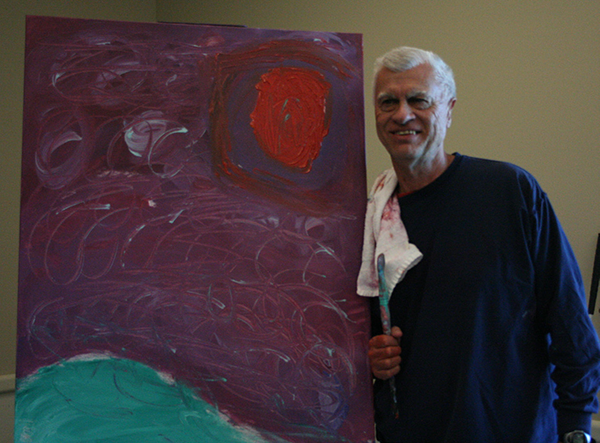Colors of the wind gets colorful

Chester Mendoza/The Skyline View
Blind artist Geroge Mendoza poses with one of his artworks which is still a work in process.
Learning how to make life a beautiful experience when living with a degenerative eye disease is what legally blind artist George Mendoza talked about with students yesterday at Skyline’s “Colors of the Wind” event.
The event started off with a room packed full of people and Jessica Powers, the author of “Colors of the Wind,” narrating the book. The story talks about George Mendoza, a fifteen year old boy at the time, who was going blind from a degenerative eye disease. Mendoza had lost his central vision, but unlike most others he started to see things that weren’t there, things such as objects that were multiplied, floating eyes and numerous colors. To some that could seem to be a scary experience, but for Mendoza he called this his “Kaleidoscope eyes,” which resulted in his beautiful works of art.
He turned his weakness into his strength, and set the world record for the mile for blind runners, and also competed in the 1980 and 1984 Olympics for the Disabled. Mendoza is now a full time artist. His collections, which are titled “Colors of the Wind,” is a national Smithsonian Affiliates Traveling Exhibit.
Mendoza explained that, though he is happy with where he is at in life now, that wasn’t always the case. He went through depression and almost becoming suicidal when he was 15. He poured his visions into art. His running helps with all the dazzling colors that he says he sees and, though at times he does get tired, he says a lot of what he sees are ghostly images and visual distortions all day long. Mendoza has a great sense of humor. He made comments about how he sees eyes watching him.
“There are eyes, but all female eyes.” said Mendoza with a laugh.
When Mendoza dreams he said he dreams in color and that most of his dreams are turned into paintings. A canvas was set up in the far right corner of the room and displayed on the canvas were markings, and those markings represented a combination of ocean waves, hills and a big sun, Mendoza started to pick up the colors with his hand and spreading them across the canvas. He says that he can tell what the colors are if he gets really close to it, but that sometimes results in paint getting on his nose. There goes that sense of humor again. The tactility of the paint helps him.
He will be donating that painting to the Skyline Campus, sometime in the Spring semester, so keep your eyes peeled for that. We’re sure the finished piece is going to be wonderful.
Powers, who also goes by J. L. Powers, spoke about what inspired her about George’s story.
“George is an inspiring figure,’ said Powers. “Not overcoming his challenge, but using it to succeed.” Students who also had attended the event had taken away something valuable from the whole experience. Faatuaii Seumanutafa, a student who had come to the event with her teacher, enjoyed it very much.
“We get a visual of what he sees, when he is painting,” said Seumanutafa.
Another student, Jeena Daya, also came with her professor and stated what she liked most about the experience.
“I like that he doesn’t let his disability stop him,” said Daya. Even friendlier and funnier up close, Mendoza spoke about some other things that interest and inspire him.
“Long Distance walks in the dessert,” Mendoza said. “Things that move and float inspire me to do abstract stuff.”
Update: a photo was added to the article. 12:37 p.m. 11/6/2014












